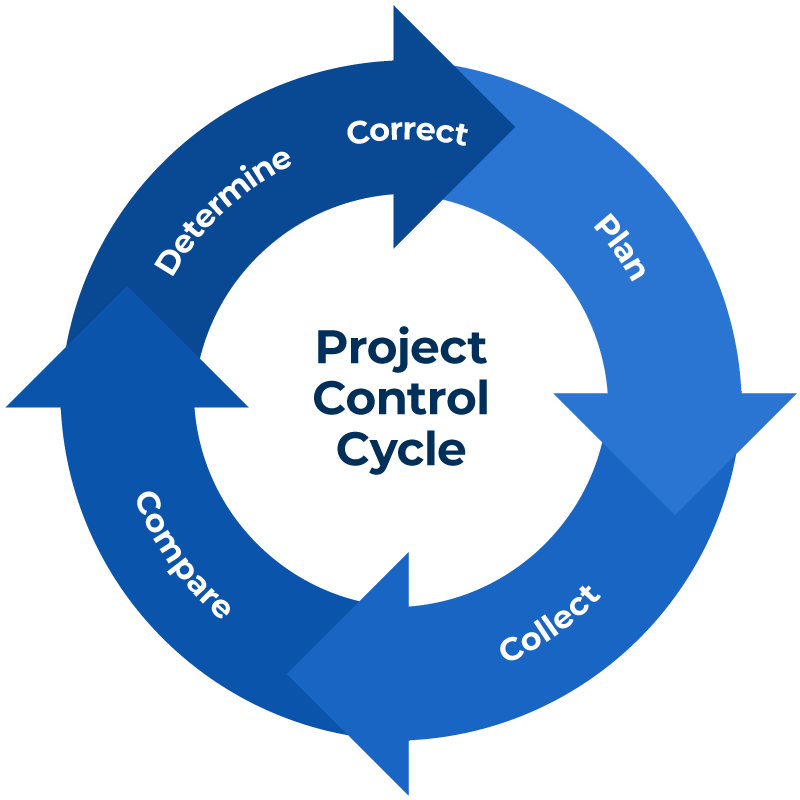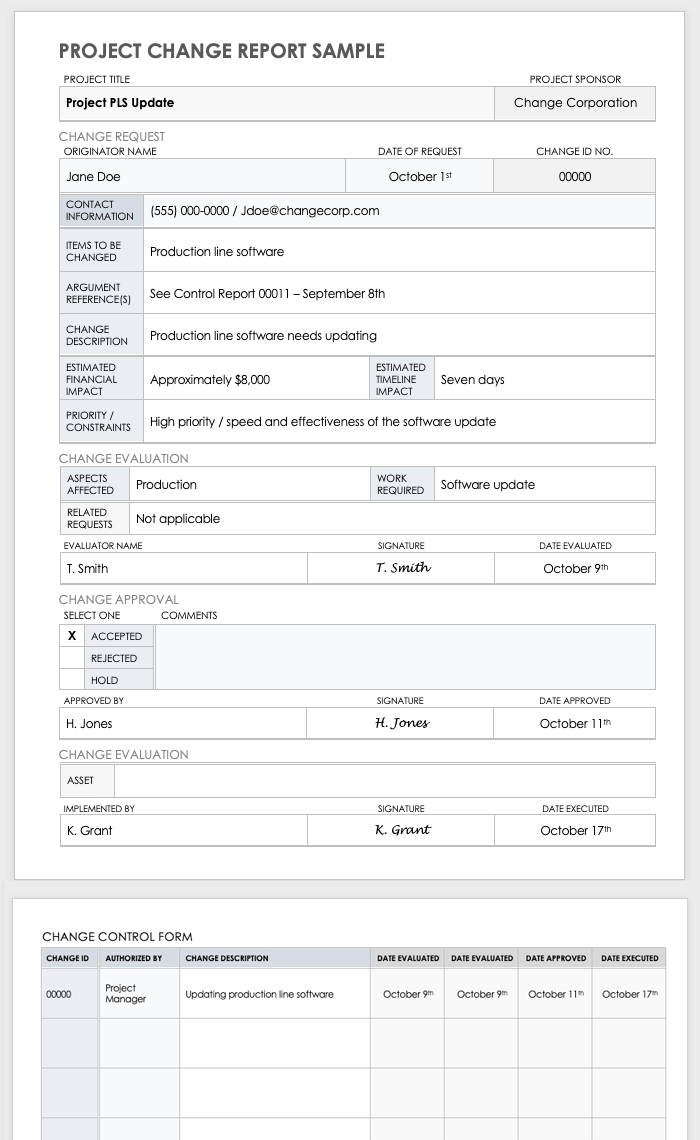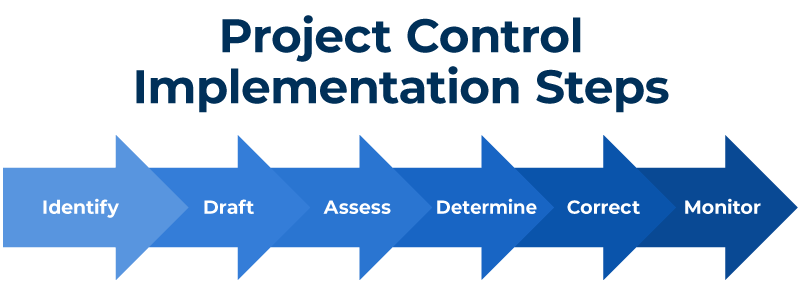What Are Project Controls?
Project controls are processes that minimize the performance gap between planning and execution. While project controls often refer specifically to the monitoring and controlling stage of the project lifecycle, they are important from initiation to closure. Project control specialists use project controls to mitigate risk and solve problems in order to keep a project on time and budget.
What Are Project Control Processes?
Project control processes help ensure that performance meets standards. Control processes are data-driven, efficient, and highly visible. Project managers must first identify a performance problem, and then determine what caused it and how to fix it.
Instituting project controls involves a four-stage process:
- Establish performance standards to create a baseline.
- Measure performance through data collection.
- Compare performance to the baseline to identify deviations and determine their causes through data analysis.
- Correct the performance deviation to keep the project on time and on budget.
Project Management Guide
Your one-stop shop for everything project management

Ready to get more out of your project management efforts? Visit our comprehensive project management guide for tips, best practices, and free resources to manage your work more effectively.
Importance of Project Controls
Project controls are vital to a project’s success. They help maintain scope, schedule, cost, and quality to minimize the waste of resources such as time and money. Project controls help the team make the best decisions to complete a project successfully.
Project Control Cycle
The project control cycle puts project controls into action. Follow each step and repeat the cycle in order to anticipate and fix deviations from the plan.
- Create a baseline plan for project performance and progress.
- Collect and measure progress data against the baseline.
- Analyze and compare actual progress and performance to the baseline.
- Identify and determine the causes of variations in performance from the baseline.
- Correct the deviation and repeat steps 2 through 5.
Project Control Methods
Project control methods should be precise and data-driven. A project manager needs to understand the problem, what caused it, and how to fix it to save time and money. Specific project controls perform particular functions.
- Project Charter: Successful projects begin with an all-encompassing overview, which you can provide by creating a project charter. A detailed project charter should list the critical components with precision and clarity.
- Responsible, Accountable, Consulted, Informed (RACI) Matrix: A RACI matrix defines project team members’ association according to their task assignments. Read our RACI guide to learn more about each association role and the value of a RACI matrix.
- Work Breakdown Structure (WBS): A WBS begins with a project outcome. Then, the structure breaks down the outcome into smaller deliverables and identifies the tasks necessary to deliver them.
- Critical Path Method: The critical path method helps you identify essential tasks of a project in terms of time. This six-step method divides a project into work tasks and calculates the time it will take to complete each task.
- Project Milestones: A project milestone is a specific point in the project lifecycle that marks important dates, such as the start, end, and review, and deliverable due dates. Find the best milestone template for your project in its working format in order to help your team achieve those milestones.
Components of Project Controls
Project control components inform project managers and teams to make better decisions and stay on task. Controlling these components puts an organization’s resources to best use in achieving project outcomes.
- Scheduling: Project control components begin with a project schedule that lists tasks and assignments, as well as the time required to complete them. A Gantt chart illustrates tasks and important dates along a project’s timeline and schedule.
- Costs: A cost management plan optimizes project resources in financial terms, which makes it a vital project control component. In this component, you estimate costs and anticipate financial risk in order to keep a project on budget.
- Risk: Project controls identify and mitigate risk for a project. Risk threatens projects and organizations, so it’s critical to have a risk management plan that identifies risks and predicts outcomes.
- Performance: Project controls work best during the monitoring performance phase, as they serve to identify baseline deviations, and then correct them. When you consider the primary function of project controls, this component immediately comes to mind.
- Communication: Project controls evaluate and report project status throughout the project lifecycle, so it’s vital to maintain clear and consistent communication with the project manager. Status reporting keeps the project team on task and provides stakeholders with valuable information.
How to Create a Project Control Plan
An effective project control plan establishes a baseline for the project controller to follow, and provides the clarity, consistency, and flexibility needed for successful project execution. Project controllers follow these steps to create a project control plan:
- Strategize a Plan with a Specific Project Controls Approach in Mind: Not all projects are alike, so create controls that are particular to the project. A project change control plan template documents everything needed in a change request.
- Create an Editable Project Control Plan: Flexibility and adaptability are essential qualities for resolving issues and keeping a project on track. You can use a change control template to identify the change, explain why it is necessary, and estimate the time and money required to complete it.
- Customize Task Schedules and Workflows to Ensure the Controls Cover Everything During the Project Lifecycle: It costs time and money when you miss and fail to fix a problem. A change control plan identifies the controller requesting the change and catalogs it with an identification number.
- List Specific Guidelines for Project Control Duties and Tasks: Controls must be consistent from project initiation through closure. The control form lists change evaluation, approval, and execution dates for consistency throughout the project lifecycle.
Download Project Change Report Template
Download Project Change Report Template
Use this customizable template as a guide for creating a project change control document to detail the what, why, and who of a change request. This template also provides space to add brief summaries of evaluation, approval, and implementation. Add the impact and work required, along with approval status and signatures.
See more of our project templates in “The Ultimate Guide to Project Cost Management with Templates.”
How to Implement Project Controls
You should implement project controls at the project’s start, and they should be in place before forecasting begins. At this point, performance standards are already in place, so project controllers and control specialists implement controls when actual performance deviates from the baseline.
To do so, follow the below steps:
- Identify the issue.
- Draft an issue log.
- Assess the issue’s impact on cost and schedule.
- Determine how to resolve the issue.
- Correct the issue by implementing the solution.
- Monitor the solution to determine its effectiveness.
Project Control Department Functions
Project control departments advise project managers and keep project stakeholders informed to help them make the best decisions. Control departments operate externally and remotely to perform the following basic functions:
- Meet and assign control tasks to department members who specialize in them.
- Monitor project performance to identify problems.
- Create solutions to fix the problems and minimize risk.
- Report to and advise the project manager.
Best Practices for Project Controls
Skillfully administered project controls increase the likelihood of project success. Use the following project control best practices to optimize project team performance and project outcome:
- Tailor and contextualize project controls to the specific industry, project management style, or situation to save time and money. There is no one-size-fits-all approach when it comes to project controls.
- Be proactive. Project controls are more effective sooner than later. Reworking grows exponentially in terms of time and expense the further along a project is.
- Use key performance indicators (KPIs) to optimize team performance for specific tasks. Designing or finding the right KPI dashboard makes the difference.
- Implement project controls that promote accountability and empowerment in the project team.
Benefits of Project Controls
Project controls collect and analyze data, and help keep projects on task and schedule. Because controlled projects achieve their outcomes on time and within budget, project controls have many benefits, including these noted by two experts:
Elizabeth Harrin, an experienced project manager, author, and mentor, describes the benefits of project controls: “Project control data is essential for communication, forming the basis of standard and exception reporting to help stakeholders feel confident that the project team is performing well. Controls help the team recognize trends that may cause issues and keep the project moving forward in the right way, meeting agreed-upon commitments.”
Alan Zucker is the founder of Project Management Essentials, LLC and has more than 25 years of project leadership and management experience. He lists the benefits of project controls at specific parts of the project lifecycle: “Project controls at the front end of a project promote sticking to the objectives, avoiding redundancy or conflicting controls. During the lifecycle, controls identify problems, allowing for course corrections to determine feasibility. Back-end controls ensure the final project meets expectations, quality standards, and the specific needs of customers.”
Project controls deliver real-time status reporting for accuracy and transparency, and they boost confidence in the organization. Controls improve job satisfaction in the project team and provide benchmarks for future projects.
Challenges of Project Controls
With excellent implementation, monitoring, and analysis, project controls deliver. That said, it’s important to have an awareness of some common pitfalls in order to avoid them.
Elizabeth Harrin shares her expertise and experience with project control challenges: “The main challenge of project controls is that it’s not an exciting part of project work. Stakeholders may not value gathering data and producing project reports.” Additional challenges occur when “project teams do not have the tools or internal support to do the best possible job controlling the project. Team members aren’t always able to interpret the data effectively. Transparent and straightforward is what’s needed, but projects are complicated, and often it’s not as easy as saying, ‘We’re 72 percent complete’. “
Alan Zucker offers this significant project controls challenge: “Highly controlled projects can hinder the process. Adequate project controls must meet the moment, and a good controls framework requires the proper project controls.”
Project control challenges can turn a project upside down, causing delays and cost overruns. Scope creep occurs when project deliverables and size increase due to unexpected problems. Identifying and understanding the causes of scope creep can help you get a project back on track and avoid the issue in future projects.
A change management plan and a risk register can help project teams tackle control challenges head-on. Projects with a change management structure in place control and adapt to change more successfully. A risk register evaluates risks and prioritizes the most problematic ones in need of mitigation.
What Is the Difference Between Project Control and Project Planning?
Project planning directs the project team’s work to complete the project and achieve the desired outcome, whereas project controls use data analysis to monitor performance and keep project teamwork on task, as guided by the project plan.
For more information, read our comprehensive guide to project planning.
Project Control vs. Project Management
Project management oversees the processes, resources, and teamwork needed to complete a project successfully. Project control helps to inform project management by reporting on project status and performance.
To learn more, visit our comprehensive guide to project management.
The Difference Between a Project Controller and a Project Manager
A project controller monitors a project’s status by collecting and analyzing data to solve problems or anticipate them. Project controllers use data science to advise project managers and help them make informed decisions.
Project managers meet with stakeholders and plan the whole project. They direct the project team’s work, and they are ultimately responsible for seeing the project through on time and budget.
Sometimes, a project manager may assume the duties of a project controller. Project control specialists and departments often take on project controller duties because the time and money dedicated to projects demand it.
Discover how to demystify the five phases of project management.
Project Control Software
Project control software is essential to project success because they require you to continually gather and analyze data. A vital tool, control software provides constant attention to projects, performing real-time automated tasks and using algorithms for forecasting.
Strong project control software features planning, budgeting, and forecasting tools that minimize risk and improve performance. Control software tracks progress and forecasts outcomes with greater accuracy, saving time and money.
Get the Most Out of Project Controls with Smartsheet for Project Management
From simple task management and project planning to complex resource and portfolio management, Smartsheet helps you improve collaboration and increase work velocity -- empowering you to get more done. The Smartsheet platform makes it easy to plan, capture, manage, and report on work from anywhere, helping your team be more effective and get more done. Report on key metrics and get real-time visibility into work as it happens with roll-up reports, dashboards, and automated workflows built to keep your team connected and informed. When teams have clarity into the work getting done, there’s no telling how much more they can accomplish in the same amount of time. Try Smartsheet for free, today.




